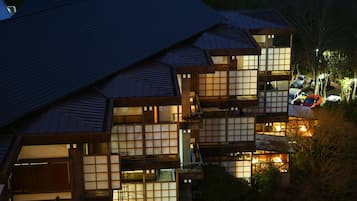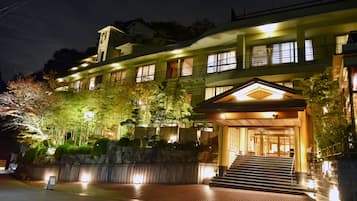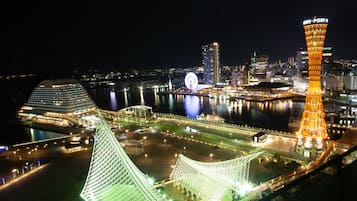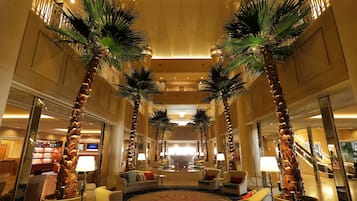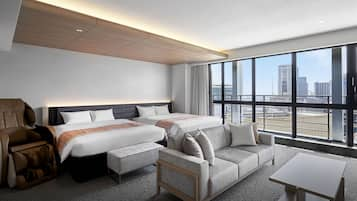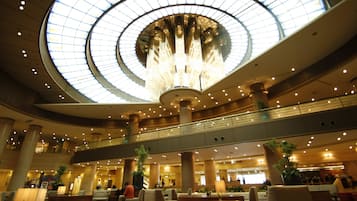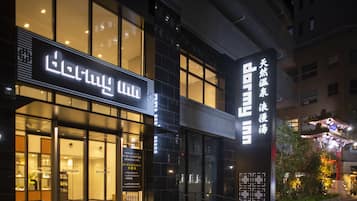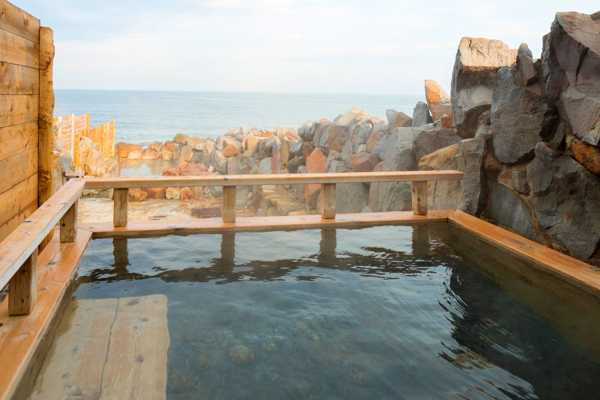Hyogo is a treasure trove of both seafood and mountain food. The town faces the Seto Inland Sea and the Sea of Japan. It's really a foodie's paradise, with the world-famous Kobe beef and exquisite luxuries such as Kami crab, Akashi octopus and conger eel. Kobe has endless places where you can try delicious Bifukatsu (beef cutlets) ranging from long-running Western-style restaurants to sandwich shops. But gastronomy in Hyogo isn't limited to high-class cuisine. Nikuman (pork-filled bun) is hugely popular all over Japan, but it actually originated in Nankinmachi, Kobe. Then there's Sobameshi (soba and rice cooked together), which is also from Kobe, and is so popular that it's even sold as a cold snack. And for Akashiyaki, a predecessor to the world-famous Takoyaki, there's nowhere better than Akashi itself. Join us as take a tour of restaurants where you can enjoy the full smorgasbord of Hyogo's delicious local cuisine.
- 1
Kobe Plaisir (Kobe beef steak)

- Ζευγάρια
- Οικογένειες
- Φαγητό
Tajima beef is now world-famous as a delicious type of Wagyu. Tajima beef that clears even stricter standards becomes what is called Kobe beef. If you're visiting Hyogo Prefecture, this is the best place in the world to try the real thing: Kobe beef steak. At the Kobe Plasir restaurant in Sannomiya, Kobe, which is directly managed by the JA Zenno Hyogo agricultural cooperative, you can tuck in to sublime Tajima beef and seasonal vegetables made by local producers from Hyogo. The lunch menu is made up of two options, a Tajima beef thigh menu and a Kobe beef steak menu, both of which are served with plenty of seasonal vegetables. 100 grams of Kobe beef sirloin is cooked on an iron plate right in front of you, with garlic rice served to complement the meat. Dessert and after-dinner drinks can be enjoyed in a separate room. To get here you'll need to take a 3-minute walk from Sannomiya Station.
Τοποθεσία: 1F The B Kobe, 2-11-5 Shimoyamatedori, Chuo-ku, Kobe-shi, Hyogo 650-0011, Japan
Ώρες λειτουργίας: Open from 11.30 am to 3 pm and 5 pm to 10.30 pm Closed on Mondays (open if Monday is a public holiday, in which case closed on the following Tuesday)
- 2
Honke Kimuraya (Akashi-yaki)

- Οικονομική διαμονή
- Φαγητό
Akashiyaki is a dish of fluffy octopus-filled dough balls dipped in warm soup stock. Locals reckon the dish, which originated in Akashi, is completely different to the more famous takoyaki. It's a simple, delicious, down-to-earth meal that's highly rated within Japan's so-called second tier of gastronomic delights. The Uontana shopping district is home to several Akashiyaki restaurants, but the reputed originator of this dish is the Honke Kimuraya restaurant in Kajiya-cho. The restaurant itself was established in 1918, but even before then it was operating as a food stall. Akashiyaki is so soft that it simply falls apart when served on a flat plate, so instead it's dished out on slanted red boards. This particular restaurant calls its Akashiyaki "Tamagoyaki" and is served in lots of 20 pieces per person. To get here, take the train to Akashi Station on the JR Sanyo Honsen Line and then walk for about 5 minutes.
Τοποθεσία: 5-23 Kajiya-cho, Akashi City, Hyogo Prefecture 673-0884, Japan
Ώρες λειτουργίας: Open from 10 am to 5.30 pm (open from 9 am on weekends and holidays) Closed on Mondays and other irregular holidays
φωτογραφία από Richard, enjoy my life! (CC BY-SA 2.0) τροποποιήθηκε
- 3
Gyoza Senmonetn Akaman Motomachi Store (Gyoza)

- Οικονομική διαμονή
- Φαγητό
Reportedly even more delicious than Japan's three main dumplings (Utsunomiya, Hamamatsu, and Hachiman) are the dumplings of Kobe's Chinatown. Ask any local and they'll tell that you it doesn't get any better than the gyoza dumplings served at Akaman. In fact, this place serves nothing but gyoza and beer. And not only is it surprisingly cheap (300 yen will get you 7 dumplings), but it's also surprisingly inventive, as the gyoza are served with miso sauce. You'll make the sauce yourself by mixing chili oil, vinegar, and soy sauce with the miso provided at each table, and apparently a generous amount of miso makes the sauce go well with the garlic in the gyoza. With only 19 seats available, ordering to go is a good option if you see a line of poeple waiting. You can get here by taking a 1-minute walk from JR Hanshin Motomachi Station or a 2-minute walk from Kyūkyoryūchi-Daimarumae Station on the Subway Line.
Τοποθεσία: 1-11-10 Motomachidori, Chuo-ku, Kobe City, Hyogo Prefecture 650-0022, Japan
Ώρες λειτουργίας: Weekdays from 2 pm to 8 pm Weekends from 1 pm to 8 pm Closed on Wednesdays
- 4
Roushouki (Butaman)

- Φαγητό
The steamed manju buns filled with meat that the people of Kansai call "Butaman" for their pork filling actually originated in Nankinmachi, Kobe. The Roushouki shop was founded in 1915. The concept began with an attempt to make the Chinese steamed buns known as Tenchinpaozu (from the Tianjin region of China) easier for the Japanese people to palate and pronounce, which led to the invention of the "Butamanju", aka the Butaman. At any rate, the Butaman here are 100 yen each, which is a great bargain. The umami oozing from the hot, steamy soup is amazing. There are only 16 seats inside, but most customers take away, so you should be able to find somewhere to relax and eat slowly if you prefer. And takeaway is possible as long as you're buying at least 3 buns. You can get here by taking a 5-minute walk from JR Tokaidao Motomachi Station or a 3-minute walk from Kyūkyoryūchi-Daimarumae Station on the Kaigan Line.
Τοποθεσία: 2-1-14 Motomachidori, Chuo-ku, Kobe City, Hyogo Prefecture 650-0022, Japan
Ώρες λειτουργίας: Open from 10 am to 6.30 pm Closed on Mondays
- 5
Yoshoku no Asahi (Beef cutlet/Western-style cuisine)

- Ζευγάρια
- Οικογένειες
- Φαγητό
Beef cutlet is right at the top of the list of Kobe's gastronomic delights. When breaded and fried cutlets first came from the West into Japanese cuisine in the Meiji period, beef was apparently the standard meat used in such dishes. Kobe has countless establishments that serve beef cutlet, but the ever-popular Yoshoku no Asahi is exceptionally good. As served here, the beef cutlet comes with a salad and free refills of rice. The cutlet itself is a thick piece of beef fried until crispy on the outside but still pink on the inside, and this arrives with an exquisite demi-glace that has been simmering for 3 days. Other popular items on the menu include pork chops and omurice (omelette filled with rice). To get here, take a 10-minute walk from the North Exit of Kobe Station on the JR Tokaido Honsen Line.
Τοποθεσία: 8-7-7 Shimoyamatedori, Chuo-ku, Kobe City, Hyogo Prefecture 650-0011, Japan
Ώρες λειτουργίας: Open from 11 am to 3 pm Lunch only, with temporary closure
- 6
Aomori (Sobameshi/Okonomiyaki)

- Οικονομική διαμονή
- Οικογένειες
- Φαγητό
Sobameshi is famous throughout Japan as an earthy gourmet dish that originated in Kobe. It's even popular as a cold snack. As the name suggests, sobameshi combines finely chopped yakisoba noodles mixed with fried rice. This dish was created at the Aomori restaurant in Nagata-ku, Kobe, originally as a secret menu item for regulars only, and eventually the secret got out. Having started out as an okonomiyaki restaurant in 1957, most customers now come to Aomori for the sobameshi. Order large sobameshi and you'll get a hearty meal that includes cabbage, one yakisoba ball, a half portion of rice and bokkake (simmered tendon and konjac). You can typically expect to spend betwen 1,000 and 2,000 yen. To get here, take the train to JR Shin-Nagata Station and then walk for about 6 minutes.
Τοποθεσία: 4-8-6 Kubocho, Nagata-ku, Kobe City, Hyogo 653-0041, Japan
Ώρες λειτουργίας: Open from 11.30 am to 2.30 pm and 5 pm to 10.30 pm Closed on Tuesdays
- 7
Noko (Himeji Oden)

- Οικονομική διαμονή
- Φαγητό
Himeji Oden is one of the famous gastronomic delights of Himeji City. Originally known as "Kanto-daki", there are two distinct types of oden: the Kanto style of strongly flavoured oden using dark soy sauce, and the Kansai-style lightly flavoured version. The base of Himeji oden can be either of the above, but the key thing is to eat it with a ginger soy sauce. Ginger used to be produced in the area around Himeji, so its roots are local. If you want to try Himeji oden, head to the Noko oden restaurant, which is hugely popular with the locals. With the oden here, you're supposed to mix the ginger soy sauce with some of the soup and then dip the ingredients into this mixture before eating. The menu of oden items includes tendon (hard and soft), cooked tofu, crown daisy, mochikinchaku (mochi in a pouch of fried tofu), and chikuwa. To get here, take the train to JR Himeji Station and then walk for about 5 minutes.
Τοποθεσία: 1F Shirogane Building, 107 Shiroganemachi, Himeji City, Hyogo 670-0902, Japan
Ώρες λειτουργίας: Open from 5 pm to 10 pm Closed on Sundays and holidays
φωτογραφία από hirotomo t (CC BY-SA 2.0) τροποποιήθηκε
- 8
Sumiyaki Anago Yamayoshi (Anagomeshi/Japanese cuisine)

- Φαγητό
Hyogo Prefecture has more to offer than just Kobe beef. The local clientele are huge fans of conger eels. Charcoal-grilled conger eels are sold on Awaji Island, where they're produced, and at fishmongers in Himeji. Anagomeshi is basically conger eel on top of hot rice, which is an absolute gem of a dish. Fans of conger eels tend to have their own go-to fishmongers. Sumiyaki Anago Yamayoshi is a restaurant that specialises in conger eels. It has the ambience of a city dining hall, and the fragrant scent of conger eels grilled over charcoal is mouth-wateringly good. The Yamayoshi set meal is a good place to start. It includes Anagomeshi with grilled conger eel, soup and pickles. Surprisingly for such a reasonable price, you get a whole eel. To get here, take the train to JR Himeji Station and then walk for about 3 minutes.
Τοποθεσία: 301 Ekimaecho, Himeji City, Hyogo 670-0927, Japan
Ώρες λειτουργίας: Open daily from 11 am to 8 pm Open all year round
- 9
Ajidokoro Kiichi (Seafood)

- Φαγητό
- Πολυτέλεια
Delicious crabs abound on the Sea of Japan side of Hyogo Prefecture. The area west of Kinosaki, where Kinosaki Onsen is located, is even called the "Crab Coast". Crabs are referred to by the name of the place where they were landed, with "Kami crabs" landed at the Kami fishing port particularly prized as luxury ingredients at high-end restaurants in Tokyo, Kyoto, and Kobe. If you actually come to Kami, you can try the real thing at incredibly reasonable prices. Ajidokoro Kiichi is a specialist seafood shop located in the heart of Kami. The price of crab changes depending on the season, and the cooked crab and all-crab courses are especially popular. But also don't forget to try the sashimi of local fish, octopus tempura and other delicious morsels. To get here, take the train to JR Kami Station and then walk for about 10 minutes.
Τοποθεσία: 1037 Kasumi, Kasumi-ku, Kami-cho, Mikata-gun, Hyogo 669-6544, Japan
Ώρες λειτουργίας: Open from 11.30 am to 2 pm and 5.30 pm to 9 pm Closed on Wednesdays
- 10
Zekkei Restaurant Uzunokuni (Awaji Island seafood)

- Φαγητό
- Φωτογραφία
Awaji Island is a renowned production site for fresh and delicious ingredients such as onions, sea urchins, pike eel, and masu salmon. Zekkei Restaurant Uzunokuni is a great place to sample dishes made using local ingredients from Awaji Island. "Uzunokuni Seafood Sea Urchin Shabu-shabu" is as delicious as it sounds, serving up the incredible umami of fresh sea urchin in an inspired recipe. This is a true celebration of sea urchin: you can dip skewered fresh local seafood into the rich sea urchin soup, on top of which there's raw sea urchin served with sea urchin soup, and finally there's sea urchin rice gruel. The reasonably priced "Namashirasu" (raw whitebait) rice bowl is also popular. All of the dishes here are made using seasonal ingredients, so the menu will be different depending on when you visit. The restaurant is only open at lunchtime, and it's a good idea to come by car. Alternatively, there's a free shuttle bus from Fukuoka Port, but this doesn't run very frequently.
Τοποθεσία: 936-3 Hei Fukura, Minamiawaji City, Hyogo 656-0503, Japan
Ώρες λειτουργίας: Open from 10 am to 3 pm Closed on Tuesdays
Χάρτηςφωτογραφία από [4K]Shike (CC BY-SA 2.0) τροποποιήθηκε





